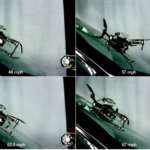
Police can now dispatch flying drones to answer 911 calls with the press of a button. Coastal cities in the U.S. could be facing a new housing crisis in the next few decades. Some ransomware gangs are calling victims they suspect might try to restore from backups to avoid paying ransom demands.
***
Police are now using drones equipped with artificial intelligence similar to the technology in self-driving cars to help in their investigations, presenting new civil rights questions and posing privacy risks, according to a new report from The New York Times.
Each day, police in the Southern California city of Chula Vista respond to as many as 15 emergency calls with a drone as part of a program called Drone as First Responder. Chula Vista’s police drones can cover about one-third of the city from two launch sites, responding to roughly 70 percent of all emergency calls. After asking the Federal Aviation Administration to approve a third launch site, the local police hope to cover the entire city, about 52 square miles between San Diego and the Mexican border.
However, while the latest drone technology can assist in police investigations, it also raises civil liberties concerns, especially as drones gain the power to track vehicles and people automatically. As the police use more drones, they could collect and store more video of life in the city, which could remove any expectation of privacy once you leave the home.
The report gave an example of a drone sent “across the city to a crowded parking lot where a young man was asleep in the front seat of a stolen car with drug paraphernalia on his lap. When the man left the car, carrying a gun and a bag of heroin, a nearby police car had trouble following as he sprinted across the street and ducked behind a wall. But as he threw the gun into a dumpster and hid the bag of heroin, the drone, hovering above him, caught everything on camera. When he slipped through the back door of a strip mall, exited through the front door and ran down the sidewalk, it caught that, too. Watching the live video feed, an officer back at headquarters relayed the details to the police on the scene, who soon caught the man and took him into custody. Later, they retrieved the gun and the heroin. And after another press of the button, the drone returned, on its own, to the roof.”
Source: “Police Drones Are Starting to Think for Themselves,” The New York Times, Dec. 5, 2020
***
Climate change could triple the number of affordable housing units in the U.S. vulnerable to flooding by 2050, according to a new study published in the journal Environmental Research Letters.
That amounts to more than 24,000 homes that could flood at least once a year by 2050 compared to about 8,000 in 2000. The vast majority (75 percent) of that vulnerable housing is concentrated in just 20 cities, researchers noted. They also unveiled a new interactive map that people can use to see how their hometown might be affected.
New Jersey affordable housing residents fare the worst under the study’s projections for 2050. In the model, the state has the most units at risk of flooding at least once a year: 6,825, a fourfold jump from 2000. About 45 percent of those homes could see flooding up to four times a year. New Jersey’s Atlantic City ranks as the second-highest most vulnerable city on the list, where more than half of all affordable housing could flood at least once yearly. Rounding out the top 5 most vulnerable states are New York, Massachusetts, Virginia and Florida.
The researchers said they focused on homes for lower-income residents because they’re often older buildings that could have a harder time standing up to the stress of climate-related disasters.
Source: “Rising seas predicted to flood thousands of affordable housing units by 2050,” The Verge, Dec. 1, 2020; “Sea level rise and coastal flooding threaten affordable housing,” Environmental Research Letters, Dec. 1, 2020
***
Some ransomware gangs are now cold-calling victims on their phones if they suspect a hacked company might try to restore from backups and avoid paying ransom demands.
“We think it’s the same outsourced call center group that is working for all the [ransomware gangs], as the templates and scripts are basically the same across the variants,” Bill Siegel, CEO and co-founder of cybersecurity firm Coveware, told ZDNet.
The use of phone calls is another escalation in the tactics used by ransomware gangs to put pressure on victims to pay ransom demands after they’ve encrypted corporate networks. Previous tactics included the use of ransom demands that double in value if victims don’t pay during an allotted time, threats to notify journalists about the victim company’s breach or threats to leak sensitive documents on so-called “leak sites” if companies don’t pay.
Source: “Ransomware gangs are now cold-calling victims if they restore from backups without paying,” ZDNet, Dec. 5, 2020




















 How Insurers Can Avoid Post-Merger Technology Failure
How Insurers Can Avoid Post-Merger Technology Failure  California Workers Comp Combined Ratio for 2024 Highest in 20-Plus Years
California Workers Comp Combined Ratio for 2024 Highest in 20-Plus Years  NOAA Announces Latest AI-Driven Global Weather Models
NOAA Announces Latest AI-Driven Global Weather Models  What to Expect in 2026: U.S. P/C Results More Like 2024
What to Expect in 2026: U.S. P/C Results More Like 2024 









